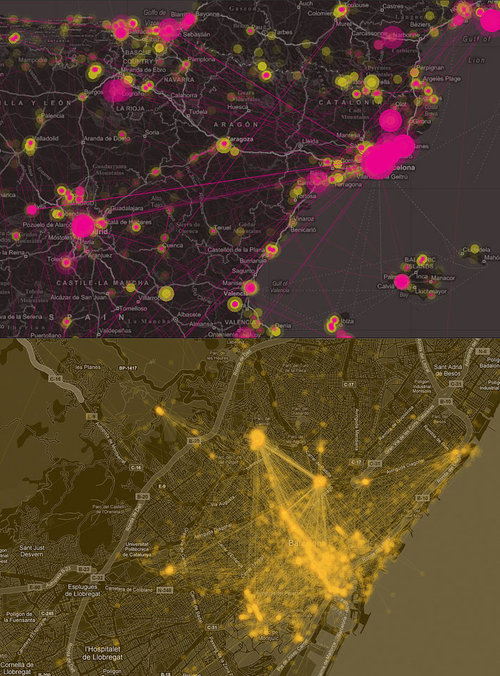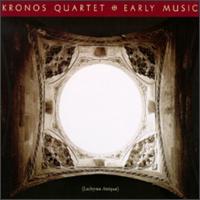Visual Merzbow from Peng Wang on Vimeo.
Thursday, December 31, 2009
Wednesday, December 30, 2009
Monday, December 28, 2009
Michael Shermer on 'Magical Thinking'
http://www.terceracultura.net/tc/en/?p=234

"Science doesn’t come naturally, because it requires additional cognitive steps, beyond just the basic pattern-seeking, pattern-connecting, connecting the dots behavior we all do that’s known as superstitious thinking. This is what I call “patternicity” (in “How We Believe”), the tendency to find meaningful patterns in random noise. Now, sometimes patterns are real and sometimes they’re not. And we make two kinds of errors. A Type 1 error, which is a false positive: you think the pattern is real, and it turns out it’s not; and a Type 2: you think the pattern’s not real, and it turns out to be real. So let’s take an example. Think of our selves back in a Paleolithic environment, in a dangerous world, and there’s a rustle in the grass. Is it the wind, or is it a dangerous predator? Well, you make a Type 1 error and you think, well, it’s probably a predator, so I’ve got to move away and be cautious, and it turns out it’s just the wind. There there’s no harm. That doesn’t take a big investment of energy. But if you make a Type 2 error and you say it’s just the wind and it turns out it’s a dangerous predator and you stand there and become lunch, you’re now taken out of the gene pool.
So I’m arguing that there is a natural selection for: “Just assume all patterns are real, and operate accordingly”. And of course, that’s just magical thinking. That’s association learning, that’s just connecting A to B and assuming there’s always a connection."
-- Michael Shermer


"Science doesn’t come naturally, because it requires additional cognitive steps, beyond just the basic pattern-seeking, pattern-connecting, connecting the dots behavior we all do that’s known as superstitious thinking. This is what I call “patternicity” (in “How We Believe”), the tendency to find meaningful patterns in random noise. Now, sometimes patterns are real and sometimes they’re not. And we make two kinds of errors. A Type 1 error, which is a false positive: you think the pattern is real, and it turns out it’s not; and a Type 2: you think the pattern’s not real, and it turns out to be real. So let’s take an example. Think of our selves back in a Paleolithic environment, in a dangerous world, and there’s a rustle in the grass. Is it the wind, or is it a dangerous predator? Well, you make a Type 1 error and you think, well, it’s probably a predator, so I’ve got to move away and be cautious, and it turns out it’s just the wind. There there’s no harm. That doesn’t take a big investment of energy. But if you make a Type 2 error and you say it’s just the wind and it turns out it’s a dangerous predator and you stand there and become lunch, you’re now taken out of the gene pool.
So I’m arguing that there is a natural selection for: “Just assume all patterns are real, and operate accordingly”. And of course, that’s just magical thinking. That’s association learning, that’s just connecting A to B and assuming there’s always a connection."
-- Michael Shermer

Labels:
ethics,
philosophy
What does simulation want?
Simulation and Its Discontents
Sherry Turkle
"Over the past twenty years, the technologies of simulation and visualization have changed our ways of looking at the world. In Simulation and Its Discontents, Sherry Turkle examines the now dominant medium of our working lives and finds that simulation has become its own sensibility. We hear it in Turkle's description of architecture students who no longer design with a pencil, of science and engineering students who admit that computer models seem more "real" than experiments in physical laboratories.
Echoing architect Louis Kahn's famous question, "What does a brick want?", Turkle asks, "What does simulation want?" Simulations want, even demand, immersion, and the benefits are clear. Architects create buildings unimaginable before virtual design; scientists determine the structure of molecules by manipulating them in virtual space; physicians practice anatomy on digitized humans. But immersed in simulation, we are vulnerable. There are losses as well as gains. Older scientists describe a younger generation as "drunk with code." Young scientists, engineers, and designers, full citizens of the virtual, scramble to capture their mentors' tacit knowledge of buildings and bodies. From both sides of a generational divide, there is anxiety that in simulation, something important is slipping away."

Sherry Turkle
"Over the past twenty years, the technologies of simulation and visualization have changed our ways of looking at the world. In Simulation and Its Discontents, Sherry Turkle examines the now dominant medium of our working lives and finds that simulation has become its own sensibility. We hear it in Turkle's description of architecture students who no longer design with a pencil, of science and engineering students who admit that computer models seem more "real" than experiments in physical laboratories.
Echoing architect Louis Kahn's famous question, "What does a brick want?", Turkle asks, "What does simulation want?" Simulations want, even demand, immersion, and the benefits are clear. Architects create buildings unimaginable before virtual design; scientists determine the structure of molecules by manipulating them in virtual space; physicians practice anatomy on digitized humans. But immersed in simulation, we are vulnerable. There are losses as well as gains. Older scientists describe a younger generation as "drunk with code." Young scientists, engineers, and designers, full citizens of the virtual, scramble to capture their mentors' tacit knowledge of buildings and bodies. From both sides of a generational divide, there is anxiety that in simulation, something important is slipping away."

Labels:
Baudrillard,
ethics,
Future,
philosophy
Friday, December 18, 2009
Thursday, December 17, 2009
Bruno Dicolla
http://www.brn.cc/
Many people believe that they are attracted by God, or by Nature, when they are only repelled by man. ~William Ralph Inge
Many people believe that they are attracted by God, or by Nature, when they are only repelled by man. ~William Ralph Inge
Tuesday, December 15, 2009
Sunday, December 13, 2009
David OReilly
Labels:
animation,
digital art
Monday, December 7, 2009
Sunday, December 6, 2009
Thousand Plateaus
"These drawings are a methodical interpretation of the first two chapters of 'A Thousand Plateaus: Capitalism and Schzophrenia' by Gilles Delueze and Felix Guattari, translated by Brian Massumi, University of Minnesota Press, 1987. The drawings were created as a means of understanding the ideas being presented in the book."








Labels:
art,
Deleuze,
Guattari,
philosophy
Monday, November 30, 2009
Friday, November 20, 2009
Tuesday, November 17, 2009
Monday, November 9, 2009
Senseable City

"The real-time city is now real! The increasing deployment of sensors and hand-held electronics in recent years is allowing a new approach to the study of the built environment. The way we describe and understand cities is being radically transformed - alongside the tools we use to design them and impact on their physical structure. Studying these changes from a critical point of view and anticipating them is the goal of the SENSEable City Laboratory, a new research initiative at the Massachusetts Institute of Technology."
http://senseable.mit.edu/
Labels:
architecture,
information,
sustainability,
technology,
urban space
TRASH | TRACK

"Why do we know so much about the supply chain, and so little about the 'removal chain'? Imagine a future where immense amounts of trash didn’t pile up on the peripheries of our cities: a future where we understand the ‘removal-chain’ as we do the ‘supply-chain’, and where we can use this knowledge to not only build more efficient and sustainable infrastructures but to promote behavioral change."
TRASH | TRACK
Labels:
ethics,
information,
sustainability,
technology,
urban space
Wednesday, October 21, 2009
Monday, October 19, 2009
Saturday, October 10, 2009
Urban surveillance game?
via BoingBoing
"Internet Eyes is a new 'game' where the public is invited to watch thousands of CCTV cameras for criminal activity. The most successful crimespotters can win cash prizes..."

"Internet Eyes is a new 'game' where the public is invited to watch thousands of CCTV cameras for criminal activity. The most successful crimespotters can win cash prizes..."

Labels:
game,
technology
Monday, October 5, 2009
Friday, October 2, 2009
architectural tourism of the unbuilt
via bldgblog
"a public art project that allows individuals to browse visionary designs for the City of New York on their iPhones."
Users can view images and descriptions of speculative projects ranging from Buckminster Fuller’s dome over midtown Manhattan, to Antonio Gaudi’s unbuilt cathedral, to Archigram’s pop-futurist “Walking City,” all while standing on the projects’ intended sites.
In other words, you go around the city, iPhone in hand – a kind of architectural dowsing rod held in front of you – discovering the traces of buildings that never were (perhaps even fragments of a city yet to come)."

"a public art project that allows individuals to browse visionary designs for the City of New York on their iPhones."
Users can view images and descriptions of speculative projects ranging from Buckminster Fuller’s dome over midtown Manhattan, to Antonio Gaudi’s unbuilt cathedral, to Archigram’s pop-futurist “Walking City,” all while standing on the projects’ intended sites.
In other words, you go around the city, iPhone in hand – a kind of architectural dowsing rod held in front of you – discovering the traces of buildings that never were (perhaps even fragments of a city yet to come)."

Labels:
architecture,
Future,
information,
urban space
Sunday, September 27, 2009
Thursday, September 24, 2009
Tuesday, September 22, 2009
Andy Warde
http://www.andywarde.com/
"Andy's paintings surprise and puzzle their audience. He creates a webbed and illusional story that cannot be fully grasped with one visual appraisal. Andy combines geometric shapes, buildings, people, animals and even plants as an interpretation of himself."



"Andy's paintings surprise and puzzle their audience. He creates a webbed and illusional story that cannot be fully grasped with one visual appraisal. Andy combines geometric shapes, buildings, people, animals and even plants as an interpretation of himself."



Labels:
art,
illustration
Monday, September 21, 2009
Friday, September 18, 2009
Cadaver Cathedral
via BLDGBLOG:
"A few weeks ago I mentioned some 3D-printed work by Yousef Al-Mehdari ... The project explores religious ritual and the human body, alongside an interest in 'transitory sculptures,' processional routes, and a kind of body-futurist rediscovery of architectural ornament. Vortices of limbs ossify into cathedrals; overlapping anatomies become windows and valves.
Al-Mehdari suggests that a careful – even mathematically exact – study of human bodily movement could serve as a basis for generating new types of architectural form. As if we could take conic sections through Merce Cunningham, say, and turn the resulting diagrams into churches.
...
The use of the human body as a generator for architectural ornament reminds me, in an admittedly tangential way, of the "cadaver cathedral" by Jeff VanderMeer – the description of which is worth quoting in full:


"A few weeks ago I mentioned some 3D-printed work by Yousef Al-Mehdari ... The project explores religious ritual and the human body, alongside an interest in 'transitory sculptures,' processional routes, and a kind of body-futurist rediscovery of architectural ornament. Vortices of limbs ossify into cathedrals; overlapping anatomies become windows and valves.
Al-Mehdari suggests that a careful – even mathematically exact – study of human bodily movement could serve as a basis for generating new types of architectural form. As if we could take conic sections through Merce Cunningham, say, and turn the resulting diagrams into churches.
...
The use of the human body as a generator for architectural ornament reminds me, in an admittedly tangential way, of the "cadaver cathedral" by Jeff VanderMeer – the description of which is worth quoting in full:
"Where the sculptures of saints would have been set into the walls, there were instead bodies laid into clear capsules, the white, white skin glistening in the light – row upon row of bodies in the walls, the proliferation of walls. The columns, which rose and arched in bunches of five or six together, were not true columns, but instead highways for blood and other substances: giant red, green, blue, and clear tubes that coursed through the cathedral like arteries. Above, shot through with track lighting from behind, what at first resembled stained-glass windows showing some abstract scene were revealed as clear glass within which organs had been stored: yellow livers, red hearts, pale arms, white eyeballs, rosaries of nerves disembodied from their host."


Labels:
aethestics,
anatomy,
architecture,
art,
Ballardian,
Nature,
sublime
Saturday, September 12, 2009
Urban Modern
via Bill Wasik via Leon Wieseltier:
"[W]hat is being celebrated here is the ideology of no ideology—the ascendancy of the Nora Ephron view of the world, which may be succinctly described as “food and drink and bathroom fixtures.” What moves such a heart most (aside from children, the poor, and the homeless) are amenities and trivialities. The conferring of importance upon the unimportant, and of unimportance upon the important: this is a mark of decadence, the cognitive inversion of people who live “mostly in aesthetic terms” because they have secured themselves materially—or so they would like to believe—against philosophy and pain. They live for lightness and distraction. Their laughter is the sound of luck. They acquit themselves of their intellectual obligations with opinions."
— Washington Diarist: Against The Plane | The New Republic
"[W]hat is being celebrated here is the ideology of no ideology—the ascendancy of the Nora Ephron view of the world, which may be succinctly described as “food and drink and bathroom fixtures.” What moves such a heart most (aside from children, the poor, and the homeless) are amenities and trivialities. The conferring of importance upon the unimportant, and of unimportance upon the important: this is a mark of decadence, the cognitive inversion of people who live “mostly in aesthetic terms” because they have secured themselves materially—or so they would like to believe—against philosophy and pain. They live for lightness and distraction. Their laughter is the sound of luck. They acquit themselves of their intellectual obligations with opinions."
— Washington Diarist: Against The Plane | The New Republic
Labels:
Aesthetics,
ethics,
philosophy
Saturday, September 5, 2009
Sweetwater Defense
I did the soundtrack for werebear games' premiere release on the iPhone "Sweetwater Defense". Includes about 7 tracks from various projects. Check it out:
http://www.werebeargames.com/

http://www.werebeargames.com/

Thursday, August 27, 2009
Jacques Gautier d'Agoty (1716 - 1785)
Wikipedia : Gautier d'Agoty
Myologie complette en couleur et grandeur naturelle







Myologie complette en couleur et grandeur naturelle
"I think the experience of dissecting a human cadaver is a profoundly moving one. There's no question that the whole process, day by day, of paring away the skin, separating the blood vessels and nerves, delving down through the muscles, laying bare the physical being that once walked this earth, is deeply moving, and is as close to a human being as one can ever get."
-- J.G. Ballard
"We have contests in which we decide who is the most beautiful woman in the world, and yet, if you were to show the inside of that woman's body, you would have a lot of grossed-out people. Why is that? We should be able to have a World's Most Perfect Kidney contest, where women or men unzip to show their kidneys. We can't become integral creatures until we come to terms with our bodies and we haven't come remotely close to that. We're incredibly schizophrenic."
-- David Cronenberg
"We left her head intact for your viewing pleasure."
-- Gautier d'Agoty
"Indeed. She lies not on her stomach, as would be necessary for the dissection of the back muscles, but sits up and peers slightly, altogether not unlike the myriad coy nudes in contemporaneous paintings. Indeed, the intertextual relation between this image and the painted nude is increased by the effect of Gautier d'Agoty's varnishing his prints to give them something of the luster of oil paintings -- the prints veritably glisten with a sheen that deepens their colors and contributes to our pleasure in looking. The mutilated woman is alert, and seemingly made up to receive us, hair carefully coiffed, eyes bright, and ears pink. She is, in short, alive and expressive. She is also predominantly the color of blood. (Gautier d'Argoty's use of color printing favored red.) The 'wings' formed by her folded-out back flesh and muscles -- the Surrealists named her the 'anatomical angel' -- seem to vibrate with blood flow, though not a drop of it is shed by the procedure."
-- 'Art and the Committed Eye' by Richard D. Leppert







Labels:
anatomy,
art,
Ballardian,
data visualization,
illustration,
information,
J.G. Ballard,
Nature,
sublime,
wall charts
Paul Pfurtscheller
"This chart comes from a series of zoological charts by Paul Pfurtscheller, a high-school teacher, biologist, and one of the early producers of wall charts. All of Pfurtscheller’s charts exhibit similar visual qualities: one large image of the whole animal surrounded by a few, carefully chosen and economically illustrated details of the anatomy. Otto Schmeil wrote about Pfurtscheller’s charts, “In my opinion, they are the most artistically accomplished wallcharts that have appeared so far." -- reference








Labels:
art,
data visualization,
illustration,
information,
Nature,
wall charts
Subscribe to:
Posts (Atom)


































